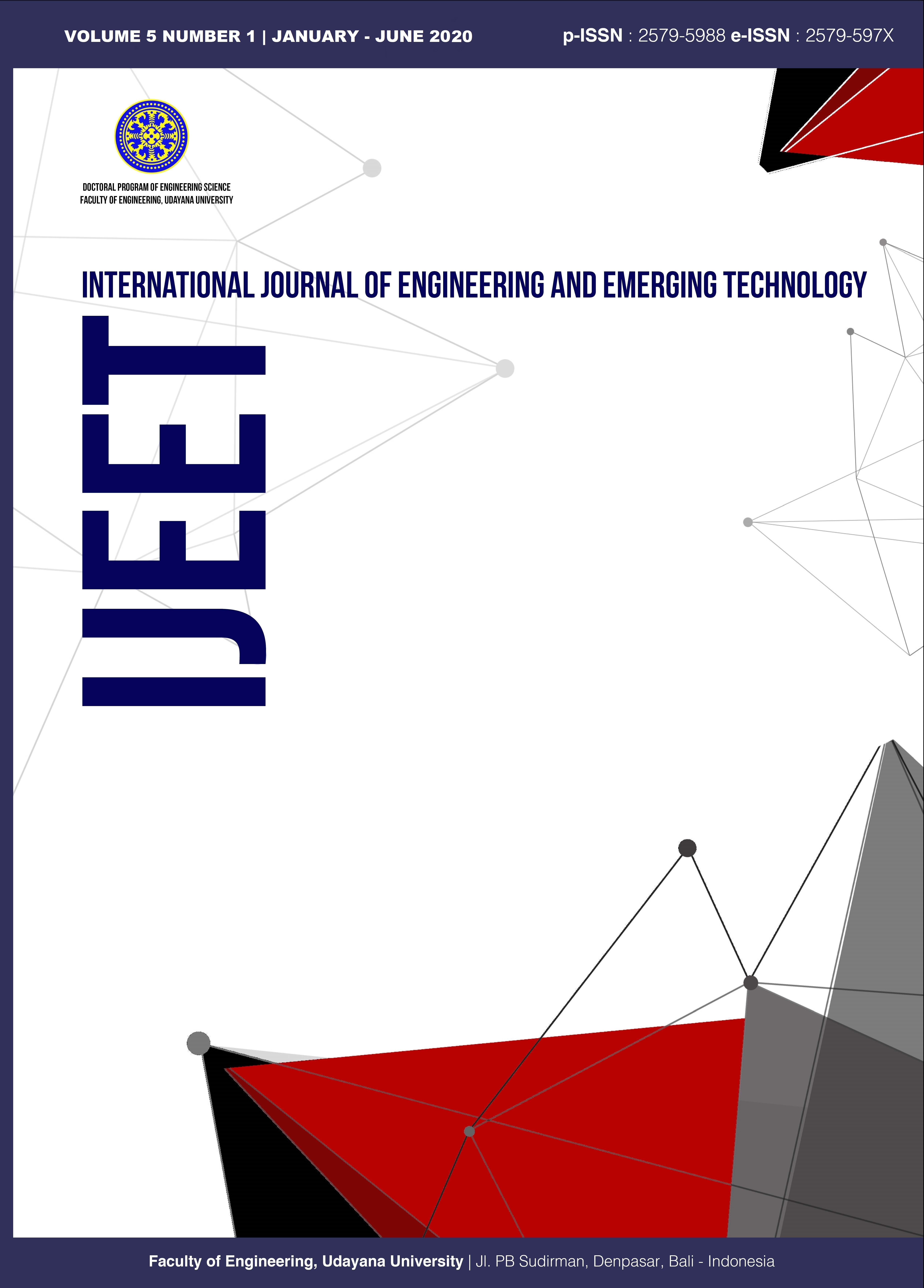Determination and Measurement of Color Dissimilarity
Abstract
There are millions of different colors that exist in this nature. There are colors that can easily be distinguished from other colors, but many are also difficult to distinguish. The ability to distinguish colors is important in the recognition of an object, especially objects in an image. Color can be represented in a three-dimensional RGB color space and each color will have an RGB value with a range of values ??from 0-255. Conceptually, colors with different RGB values ??are different colors, but the human eye may not necessarily be able to distinguish them. This study aims to determine and measure the color dissimilarity that can be distinguished by humans. With an experiment comparing a color with a color made with a variation of RGB values, this study resulted that two colors that have a Delta E (?E) value of 8 can be distinguished by the eye. This result is obtained if both colors have a value of ?R, ?G or ?B of at least 8, or a value of ?RG, ?RB or ?GB of at least 6, or a value of ?RGB of at least 5.
Downloads
References
[2] M. Safar, C. Shahabi, and X. Sun, “Image retrieval by shape: a comparative study,” in Multimedia and Expo, 2000. ICME 2000. 2000 IEEE International Conference on, 2000, vol. 1, pp. 141–144.
[3] A. Amanatiadis, V. G. Kaburlasos, A. Gasteratos, and S. E. Papadakis, “A comparative study of invariant descriptors for shape retrieval,” in Imaging Systems and Techniques, 2009. IST’09. IEEE International Workshop on, 2009, pp. 391–394.
[4] C. Shahabi and M. Safar, “An experimental study of alternative shape-based image retrieval techniques,” Multimed. Tools Appl., vol. 32, no. 1, pp. 29–48, 2007.
[5] D. Zhang and G. Lu, “An integrated approach to shape based image retrieval,” Proc. 5th Asian Conf. Comput. Vis. (ACCV), Melbourne, Aust., 2002.
[6] J. Li, J. Z. Wang, and G. Wiederhold, “Classification of Textured and Non-Textured Images Using Region Segmentation,” in IEEE International Conference on Image Processing (ICIP), 2000, pp. 754–757.
[7] G. Mandloi, “A Survey on Feature Extraction Techniques for Color Images,” Int. J. Comput. Sci. Inf. Technol., vol. 5, no. 3, pp. 4615–4620, 2014.
[8] S. Kumar and E. A. Chauhan, “A survey on feature extraction techniques for color images.”
[9] I. Bramão, A. Reis, K. M. Petersson, and L. Faísca, “The role of color information on object recognition: A review and meta-analysis,” Acta Psychol. (Amst)., vol. 138, no. 1, pp. 244–253, 2011.
[10] R. L. Adlington, K. R. Laws, and T. M. Gale, “Visual processing in Alzheimer’s disease: Surface detail and colour fail to aid object identification,” Neuropsychologia, vol. 47, no. 12, pp. 2574–2583, 2009.
[11] K. Yang, S. Gao, C. Li, and Y. Li, “Efficient color boundary detection with color-opponent mechanisms,” in Proceedings of the IEEE conference on computer vision and pattern recognition, 2013, pp. 2810–2817.
[12] M. A. Dzulkifli and M. F. Mustafar, “The influence of colour on memory performance: A review,” Malaysian J. Med. Sci. MJMS, vol. 20, no. 2, p. 3, 2013.
[13] P. Kaur, S. Thakral, and M. Singh, “Color Based Image Retrieval System,” IOSR J. Comput. Eng., 2012.
[14] S. V Sakhare and V. G. Nasre, “Design of feature extraction in content based image retrieval (CBIR) using color and texture,” Int. J. Comput. Sci. Informatics, vol. 1, no. 2, pp. 57–61, 2011.
[15] M. Wallin and R. Meganck, “Mapping Color,” 2014.
[16] L. Brun and A. Trémeau, “Color quantization,” Digit. Color Imaging Handb., pp. 589–638, 2003.
[17] A. BYRNE, “Color and Similarity,” Philos. Phenomenol. Res., vol. 66, no. 3, pp. 641–665, May 2003.
[18] D. Senthamaraikannan, S. Shriram, and J. William, “Real time color recognition,” Int. J. Innov. Res. Electr. Electron. Instrum. Control Eng., vol. 2, no. 3, 2014.
[19] X. Zhang and J. Yang, “The analysis of the color similarity problem in moving object detection,” Signal Processing, 2009.
[20] H. Zimmer and A. Steiner, “Colour specificity in episodic and in perceptual object recognition with enhanced colour impact,” Eur. J. Cogn. Psychol., vol. 15, no. 3, pp. 349–370, 2003.
[21] S.-C. Cheng and C.-K. Yang, “A fast and novel technique for color quantization using reduction of color space dimensionality,” Pattern Recognit. Lett., vol. 22, no. 8, pp. 845–856, 2001.
[22] M. Hassan and C. Bhagvati, “Structural Similarity Measure for Color Images,” Int. J. Comput. Appl., vol. 43, no. 14, pp. 7–12, Apr. 2012.
[23] M. S. Mulekar and C. S. Brown, “Distance and Similarity Measures,” in Encyclopedia of Social Network Analysis and Mining, New York, NY: Springer New York, 2017, pp. 1–16.
[24] A. Mojsilovic, H. Hu, and E. Soljanin, “Extraction of perceptually important colors and similarity measurement for image matching, retrieval and analysis,” IEEE Trans. Image Process., vol. 11, no. 11, pp. 1238–1248, Nov. 2002.
[25] S. Won and S. Westland, “Colour meaning and context,” Color Res. Appl., vol. 42, no. 4, pp. 450–459, 2017.
[26] B. Oicherman, “To develop a procedure for visual evaluation of colour differences between printed complex images,” 2003.
[27] M. Wojciech and T. Maciej, “Color difference Delta E - A survey,” Mach. Graph. Vis., 2011.
[28] D. H. Brainard, “Color appearance and color difference specification,” Sci. Color, vol. 2, pp. 191–216, 2003.
[29] L. Hadimani and N. Mittal, “Development of a computer vision system to estimate the colour indices of Kinnow mandarins,” J. Food Sci. Technol., vol. 56, no. 4, pp. 2305–2311, 2019.
[30] ViewSonic, “Technical Introduction,” 2010. [Online]. Available: https://www.viewsonic.com/uk/products/lcd/pdf/ti_delta_E.pdf.
[31] K. Minolta, “Identifying Color Differences Using L*a*b* or L*C*H* Coordinates,” 2016. [Online]. Available: https://sensing.konicaminolta.us/blog/identifying-color-differences-using-l-a-b-or-l-c-h-coordinates/.
[32] Z. Schuessler, “Delta E 101,” 2016. [Online]. Available: http://zschuessler.github.io/DeltaE/learn/.
[33] S. Mecklenbräuker, A. Hupbach, and W. Wippich, “What colour is the car? Implicit memory for colour information in children,” Q. J. Exp. Psychol. Sect. A, vol. 54, no. 4, pp. 1069–1086, 2001.
[34] W. S. Mokrzycki and M. Tatol, “Colour difference ∆E-A survey,” Mach. Graph. Vis., vol. 20, no. 4, pp. 383–411, 2011.

 Indexed By
Indexed By







